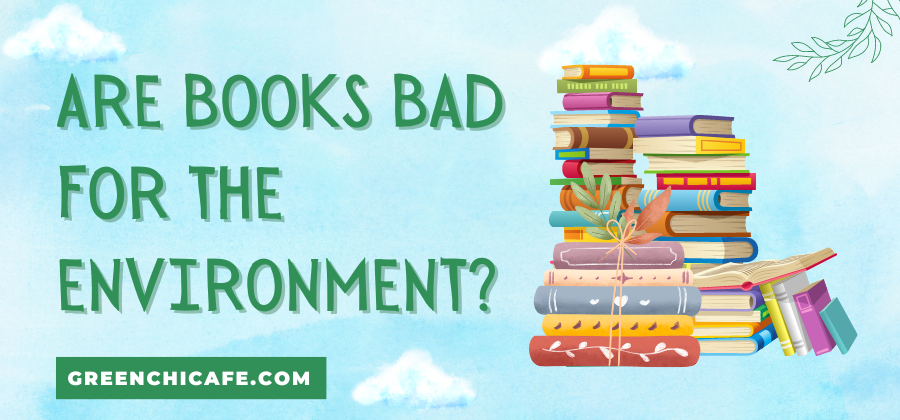Books provide knowledge, entertainment, and convenience but also require significant natural resources to produce.
This article weighs the environmental impacts of modern book publishing and explores sustainable solutions.
Read on to make informed choices as an eco-conscious reader.
Are Books Bad for the Environment?

While book publishing does carry environmental impacts, books enrich lives immensely, so sustainable solutions like supporting eco-friendly publishers, maximizing reuse, and proper recycling can reduce the literary world’s footprint.
Moderation and responsibility are key to ensuring books educate and bring joy while protecting the planet.
Key Points
- Book publishing requires extensive paper from forests and emits 30 million tons of CO2 annually.
- E-books, buying used, borrowing, and recycling books help lower impact.
- Sustainable forestry initiatives and eco-conscious publishing practices also help.
What Is the Carbon Footprint of Publishing Physical Books?
Estimates suggest the book industry generates about 30 million tons of CO2 yearly, comparable to countries like Bulgaria and Sri Lanka.
Materials, printing, transportation, and paper waste drive emissions.
How Much Wood Is Used for Paper in Book Publishing?

Global book publishing is estimated to consume over 300 million trees yearly.
E-books and recycling paper can help reduce reliance on forests.
Supporting sustainable forestry is also beneficial.
Should Consumers Avoid Buying New Books?
Buying used books significantly reduces environmental impact.
Borrowing from libraries and sharing books are other earth-friendly options without forfeiting reading.
Only buy books you’ll actually read.
Do Publishers Value Sustainability Efforts?
Many publishers seek to reduce the use of resources by streamlining printing, utilizing recycled materials, and supporting certified sustainable forestry initiatives.
Consumers can encourage these efforts.
How Has Digital Publishing Affected the Industry?
The rise of e-books has curbed paper consumption, shipping emissions, and overall waste from publishing.
But e-readers still have environmental footprints from energy used.
Moderation is key.
How Can the Disposal of Books Become More Sustainable?
Recycling is the way to go.
Recycled books properly keep paper waste out of landfills and give materials renewed purpose.
Donating used books also promotes the reuse and sharing of resources.
How Are Books Harmful To The Environment?
The production and consumption of physical books pose several harms to the environment.
Large amounts of trees are logged for paper, contributing to deforestation.
Book printing generates substantial carbon emissions and waste byproducts from inks, glues, and other chemicals.
Once purchased, paper books ultimately end up in landfills where their decomposition releases methane.
Transportation of books worldwide also produces emissions from fuel for planes, ships, and trucks.
Even e-books have an ecological impact since e-readers require energy to manufacture and charge.
While books provide knowledge and enjoyment to billions, the unsustainable scale of the publishing industry extracts a toll on forests, climate, and ecosystems.
However, through initiatives like sustainable forestry, renewable energy use, eco-friendly materials, and responsible consumption habits, the book industry can lower its environmental footprint while preserving the enriching role of books in society.
Should We Get Rid Of All Paper Books?
While shifting fully to digital formats would curb deforestation and waste from traditional publishing, abandoning paper books altogether has downsides.
Reading on screens for extended periods can strain the eyes and disrupt sleep cycles.
Paper books also do not require batteries or electricity.
Moderation and balance are key – conscientious consumers can enjoy both digital and print books responsibly through mindful consumption, favoring used books, utilizing libraries, recycling diligently, and choosing eco-friendly publishers when buying new.
The solutions lie in sustainable practices and responsible habits, not the outright elimination of either format.
How Does Reading Affect The Environment?
Reading provides knowledge, skills, and entertainment but the production and dissemination of books incur environmental costs.
Large-scale book publishing drives deforestation for paper, consumes substantial energy and chemicals during manufacturing, and generates emissions from transportation.
The disposal of paper books also impacts landfills.
However, transitioning to renewable energy, optimizing recycling, supporting sustainable forestry, and reading digitally or buying used books helps lower impacts.
Most importantly, moderate and responsible consumption of books, keeping in mind their ecological footprint, allows readers to enjoy both print and digital materials while protecting the planet.
Books enrich lives immensely, so sustainable solutions should be actively implemented to share their benefits widely.
Key Takeaways:
- Moderating consumption, maximizing the reuse of books, switching to digital versions, and supporting eco-conscious publishers and forestry helps lower the literary world’s footprint.
- Books enrich our lives and world but should be produced and enjoyed responsibly.
FAQ
Should We Shun Paper Books for E-Books?
Not necessarily – moderation is key. E-readers have environmental costs too, so balance the consumption of both formats responsibly.
How Long Does It Take Paper to Decompose?
Untreated paper decomposes in 2-6 weeks. A laminated and coated paper used in books takes longer – up to 5 years without UV exposure.
Can Publishers Eliminate Their Environmental Impact?
While likely impossible to eliminate entirely, publishers can utilize renewable energy, eco-friendly materials, and sustainable practices to lower their footprint substantially.
At GreenChiCafe, we are passionate about sustainability and protecting the amazing natural world around us.
Visit our website to learn more about environmentally friendly products and practices.
